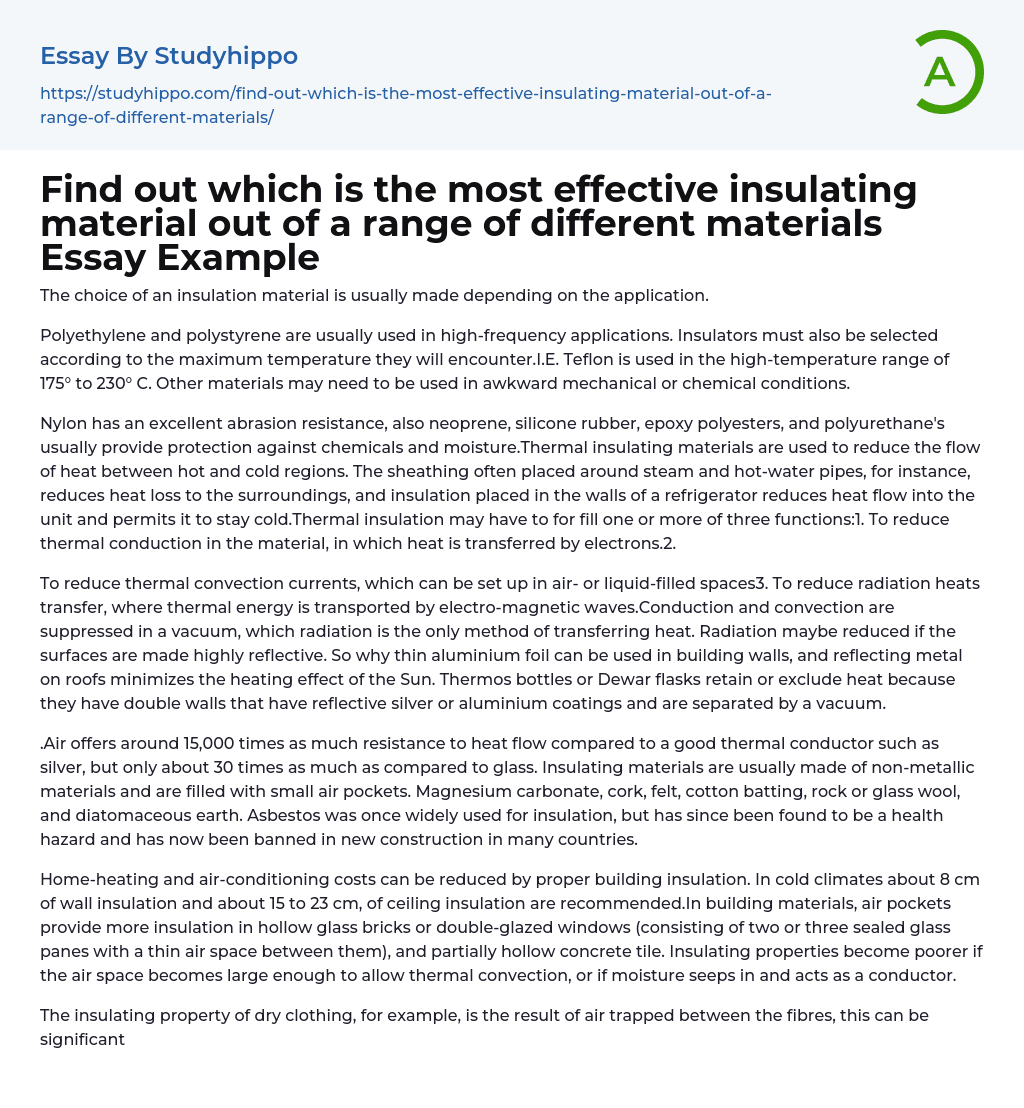The choice of insulation material is determined by the particular application.
When it comes to high-frequency applications, people often use polyethylene and polystyrene. However, for insulators, the maximum temperature expected should be considered. For instance, Teflon is utilized within a temperature range of 175°C to 230°C. In more difficult chemical or mechanical environments, other materials may be required.
Different materials provide varying forms of protection. Nylon is renowned for its exceptional abrasion resistance, whereas neoprene, silicone rubber, epoxy polyesters, and polyurethane safeguard against moisture and chemicals. Thermal insulating substances reduce the movement of heat between hot and cold zones. Steam pipes and hot-water systems are wrapped in sheathing to restrict heat loss to the environment while insulation within refrigerators walls curtails heat transfer into the unit, preserving a cool temperature. The purposes of t
...hermal insulation might involve diminishing material thermal conduction as well as limiting electron-driven heat transfer.
The purpose of reducing thermal convection currents is to prevent them from forming in air or liquid-filled spaces. On the other hand, radiation heat transfer is minimized by decreasing the amount of thermal energy transported through electromagnetic waves. When in a vacuum, both conduction and convection are eliminated, and only radiation is used for transferring heat. For this reason, surfaces can be made highly reflective to reduce radiation. To minimize the heating effect of the Sun, thin aluminium foil can be used in building walls, and reflecting metal can be used on roofs. To retain or exclude heat, thermos bottles or Dewar flasks have double walls with reflective silver or aluminium coatings separated by a vacuum.
Insulating materials, filled with small air pockets, are typically comprised of non-metallic materials such a
magnesium carbonate, cork, felt, cotton batting, rock or glass wool, and diatomaceous earth. Despite offering around 15,000 times more resistance to heat flow than good thermal conductor silver, air only provides about 30 times more resistance compared to glass. Asbestos used to be a popular insulation material until its health hazards were discovered, leading to a ban in many countries for new construction.
Proper building insulation can help cut down costs for home heating and air conditioning. The recommended wall insulation for cold climates is around 8 cm, while ceiling insulation should be around 15 to 23 cm. Building materials that have air pockets, like hollow glass bricks or double-glazed windows (made up of two or three sealed glass panes with a thin air space between them) and partially hollow concrete tile, provide better insulation. However, thermal convection can occur and the insulating properties can decrease if the air space is too large or if moisture seeps in and acts as a conductor.
The reason why dry clothing can provide insulation is because of the air trapped between the fibers. But when there's moisture, this insulating ability decreases. To solve this problem, 'The super insulator' was developed. It consists of several aluminised Mylar sheets separated by thin spacers, with around 20 to 40 layers per centimeter. Although an ideal electrical insulator would be a non-conductive material, such substance has not been discovered yet.
Insulators have a resistance to electric current that is up to 2.5 x 1024 times greater than conductors like silver and copper, but they still conduct some electricity. This is because insulators only have a limited amount of free electrons compared to conductive materials, which
contain many that can carry an electrical current.
When making transistors, it is crucial to use semiconductors such as silicon and germanium that have a restricted number of free electrons. Electrical wiring insulators are typically made from plastics, while mica or glass fibers combined with a plastic binder can be utilized for internal electrical equipment insulation. Porcelain, ceramic, or glass pieces are frequently used as insulators for high-voltage power lines. Despite this, my prediction is that bubble wrap will ultimately emerge as the most efficient material.
Bubble wrap is a good choice for insulation because it traps heat by enclosing hot electrons in the air pockets within its bubbles. To conduct an insulation experiment, you will need three large tins and three different insulating materials such as newspaper, foam, and bubble wrap. You'll also need cardboard, cellophane tape, elastic bands, a measuring cylinder, thermometer, kettle and water. Start by securing each material to individual tins using cellophane tape and separating them with round cardboard lids to avoid overlap. Use elastic bands to secure the lids before pouring 200 ml of boiling water into each tin. Take temperature measurements at intervals of 1, 3, 5 ,7 and 9 minutes before checking after 11 minutes with a thermometer. The tin that maintains the highest temperature indicates the best insulating material used. Finally clean up all apparatus.
- Atom essays
- Big Bang Theory essays
- Density essays
- Electricity essays
- Energy essays
- Force essays
- Heat essays
- Light essays
- Motion essays
- Nuclear Power essays
- Physiology essays
- Sound essays
- Speed essays
- Temperature essays
- Thermodynamics essays
- Alarm clock essays
- Factory essays
- Material essays
- Production And Manufacturing essays




